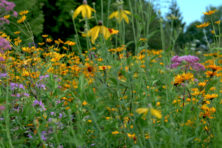Wild Ones: For Pollinators, Another Issue Has Come to Light
- Share
- Tweet
- Pin
- Share
As more gardeners and landscapers become aware of the importance of pollinators – the beneficial insects that literally keep our planet green – yet another cause of their decline has come to light. Many of the complex threats to pollinators are obvious, but I was surprised to learn that artificial light at night could affect pollination.
For years, our friends in the Door Peninsula Astronomical Society have been advocating for “dark skies.” On the Door peninsula, darkness has an economic benefit because our beautiful night skies have become one of our most popular natural tourist attractions. But artificial light has a detrimental effect on plants and wildlife as well.
According to the International Dark Skies Association, “For billions of years, all life has relied on Earth’s predictable rhythm of day and night. It’s encoded in the DNA of all plants and animals. Humans have radically disrupted this cycle by lighting up the night.
“Plants and animals depend on Earth’s daily cycle of light and dark rhythm to govern life-sustaining behaviors such as reproduction, nourishment, sleep and protection from predators. Scientific evidence suggests that artificial light at night has negative and deadly effects on many creatures, including amphibians, birds, mammals, insects and plants.
“According to research scientist Christopher Kyba, for nocturnal animals, ‘the introduction of artificial light probably represents the most drastic change human beings have made to their environment.’”
For creatures from migrating birds to breeding frogs, artificial light at night can be devastating, but aside from a few species of moths, most of our insect pollinators – wild bees, honeybees, butterflies – are active during daylight, so how could light pollution deter them? And yet, it seems to do just that.
Research, first in Europe and then in the United States, has indicated that seed production is significantly reduced where light pollution – yes, it is pollution – occurs. And that was puzzling. How can light at night change the behavior of pollinating insects during the day?
But maybe this isn’t about the insects’ behavior. Maybe artificial light is changing the behavior of plants. For years, greenhouse operators have manipulated light to change the growth patterns of plants, and botanists have known for centuries that the ratio of daylight to darkness determines the germination and blooming times of flowers.
Anyone who has ever suffered from jet lag, “pulled an all-nighter” or changed shifts at work knows that the human body is programmed to a daylight/darkness cycle, and any disruption in that cycle makes normal sleeping and activity patterns difficult. Do plants also have circadian rhythms, and could a change in the hours of light interfere with pollination? Apparently, they do and it can.
Suppose a plant has a flower that normally blooms during the morning and closes in the afternoon. If it started blooming three or four hours earlier because of exposure to artificial light, its flower might close before the day warmed up enough for pollinating insects to fly to it in the morning.
What if flowers were programmed to exude a special attracting scent when bees are most active? If the timing were off, these flowers might not be pollinated, and by extension, the insects would not find the food they need to survive.
There are countless subtle interactions in the natural world. We still don’t know about all of them. And obviously, we can’t solve the problem of global light pollution. But on a personal or even countywide scale, there are things we can do to help pollinators, migrating birds, nocturnal wildlife and, for that matter, stargazers.
There is absolutely no reason to light up the whole sky for the whole night, and all outdoor lighting should be shielded so that light is directed down, not up. Reductions in outdoor artificial lighting would also save enormous amounts of energy.
At home, people can turn off all their lights when they turn in, or better yet, put their outdoor lights on timers. Even better still where safety is concerned, they can put outdoor lights on motion sensors.
The International Dark Sky Association quotes Chad Moore, formerly of the National Park Service, who wrote, “When we add light to the environment, that has the potential to disrupt habitat, just like running a bulldozer over the landscape can.”
For pollinators, plants and wildlife – for all of us – we should make an effort to keep the night skies over the Door peninsula dark.


